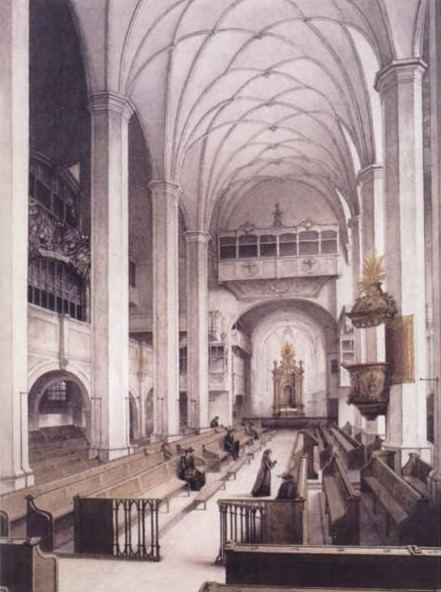Movements 6 | Cantata text anonymous | |
 | ||
Allein zu dir, Herr Jesu Christ (Only upon You, Lord Jesus Christ,), BWV 33, is a church cantata by Johann Sebastian Bach. He composed the chorale cantata in Leipzig in 1724 for the thirteenth Sunday after Trinity and first performed it on 3 September 1724. It is based on the hymn "Allein zu dir, Herr Jesu Christ" by Konrad Hubert (1540).
Contents
History and words
Bach composed the cantata in his second year in Leipzig for the Thirteenth Sunday after Trinity. That year, Bach composed a cycle of chorale cantatas, begun on the first Sunday after Trinity of 1724. The prescribed readings for the Sunday were from the Epistle to the Galatians, Paul's teaching on law and promise (Galatians 3:15–22), and from the Gospel of Luke, the parable of the Good Samaritan (Luke 10:23–37).
The cantata is based on the hymn by Konrad Hubert which was published in Nürnberg in 1540 with an added fourth stanza. Each of the stanzas consists of nine lines. For the cantata text, an unknown poet kept the words of stanzas 1 and 4 unchanged for movements 1 and 6. He transcribed the ideas of the inner stanzas, each to a sequence of recitative and aria. Due to the splitting of each stanza in two movements, the paraphrasing is a more independent from the original than for the previous cantatas of the cycle, last Herr Jesu Christ, du höchstes Gut, BWV 113. The hymn, concentrating on the sinner asking Jesus for redemption, is only generally connected to the Gospel. The poet connects to the Gospel in movement 4, "Gib mir nur aus Barmherzigkeit / den wahren Christenglauben" (Of your mercy grant me / the true Christian faith), addressing God as the true "Good Samaritan", also in movement 5, "Gib, daß ich aus reinem Triebe / als mich selbst den Nächsten liebe" (Grant that my purest impulse may be / to love my neighbour as myself"), citing the central line of the parable. The poet also refers to other Bible passages, in movement 2 to Job 9:3, "If he will contend with him, he cannot answer him one of a thousand.", and in movement 4 to both Psalms 51:13, "Then will I teach transgressors thy ways; and sinners shall be converted unto thee." and Galatians 5:6, "Then will I teach transgressors thy ways; and sinners shall be converted unto thee."
The chorale melody "Allein zu dir, Herr Jesu Christ" of unknown authorship was documented in a 1541 Wittenberg publication. It was used extensively, for example by Sethus Calvisius and Michael Praetorius. According to Klaus Hofmann, it was composed in 1512 for a secular song by Paul Hofhaimer. In the cantata, Bach uses the melody completely in a chorale fantasia in movement 1 and in the closing chorale, while he alludes to it in movement 5, a duet.
Bach first performed the cantata on 3 September 1724.
Scoring and structure
The cantata in six movements is scored for three vocal soloists—alto, tenor and bass—a four-part choir, two oboes, two violins, viola, and basso continuo.
- Chorale: Allein zu dir, Herr Jesu Christ
- Recitative (bass): Mein Gott und Richter
- Aria (alto): Wie furchtsam wankten meine Schritte
- Recitative (tenor): Mein Gott, verwirf mich nicht
- Aria (tenor, bass): Gott, der du die Liebe heißt
- Chorale: Ehr sei Gott in dem höchsten Thron
Music
In his first year in Leipzig, Bach had composed for the same occasion Du sollt Gott, deinen Herren, lieben, BWV 77, opening with a chorus on important law, on which, according to the parallel Matthew 22:34–40, "hang all the law and the prophets": "You shall love God, your Lord, with all your heart, with all your soul, with all your strength and with all your mind, and your neighbor as yourself".
The opening chorus of Allein zu dir, Herr Jesu Christ is a chorale fantasia, with the cantus firmus in the soprano, the lower voices singing mostly homophonic, but occasionally in polyphony, and expansive ritornellos framing all nine lines of the hymn. John Eliot Gardiner notes:
the fineness of the gemstone, the choral delivery of Konrad Hubert's nine-lined hymn, is in constant danger of being eclipsed by the ornate beauty of its orchestral setting, energetic in its forward propulsion, motivic invention and proto-symphonic development, through its nine instrumental ritornellos, ranging from five to twenty-four bars.
In the alto aria, movement 3, "Wie furchtsam wankten meine Schritte" (How fearful were my shaky steps), fearfulness is expressed by the muted first violins and pizzicato in the other strings, while the shaky steps appear in syncopated lines. Gardiner notes the aria's similarity to the soprano aria "Wie zittern und wanken der Sünder Gedanken" (How the thoughts of the sinner tremble and waver) in Bach's cantata Herr, gehe nicht ins Gericht mit deinem Knecht, BWV 105, composed for then 9th Sunday after Trinity the previous year. Movement 5, a duet of tenor and bass "Gott, der du die Liebe heißt" (God, whose name is love), depicts God's love in "almost naive-sounding parallel sixths and thirds", consonances in "unanimity of movement" being an image of unity that would be understood by the audience at the time. In contrast, Bach sets the words "stören Feinde meine Ruh" (should enemies disturb my peace) in lively syncopated motion, "peace" in long notes. The closing chorale is a four-part setting of the melody, with a rich setting of the words "dem Vater aller Güte ... der uns allzeit behüte" (the father of all goodness ... who may constantly preserve us) and "in der Ewigkeit" (in eternity), described by Gardiner as "an admirable melismatic interweaving of all four vocal lines at cadential points".
